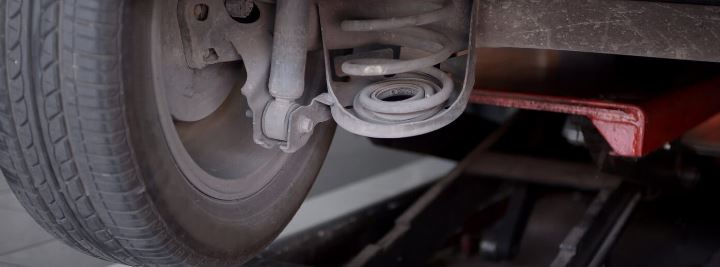The suspension system in a car is made of springs, shock absorbers and other components which are designed to give the vehicle ride comfort and handling stability while driving on various road surfaces while protecting passengers from being thrown about. The suspension system must be able to do this for all four wheels of the car in real-time.
A vehicle’s suspension is important in everyday life because it allows people to travel comfortably and safely in vehicles without having their teeth rattled out of their heads or breaking bones from being thrown around when going over bumps and cracks!
One of the most common complaints we hear about which relates to the suspension of a car is the feeling of “bounciness” when driving.
If your car feels bouncy when you drive, chances are there might be a serious problem with the suspension on the vehicle. In this blog post, we will discuss some of the most common suspension problems and what you can do to fix them. We will also provide a few tips on how to maintain your suspension and keep it in good working order so that you can reduce the risk of these problems occurring in the first place.
Lets take a look!
Common Symptoms of a Faulty Suspension System
Symptoms of issues with a cars suspension system often include :
1. Bouncing
2. Jerking
3. Shuddering
4. Vibration or shimmy
5. Poor control
As we already know a vehicle’s suspension is a crucial part of how it operates and works, an inexperienced driver can cause all sorts of problems with their vehicle if they do not know what they are doing. Some of the dangers s associated with driving a car with faulty suspension Include:
– The overall stability of your vehicle is much lower
– Easier to lose control on bends and curves in the road, making it more likely you’ll crash
– Your braking system has to work much harder than usual to maintain a normal stopping distance, increasing wear and tear on your brakes
– Unable to properly distribute the weight within the vehicle which may lead to accidents due to unbalanced distribution
Now that we know how to identify these issues , lets take a look at some of the common parts which fail.
What Are The Most Common Parts to Fail in a Suspension System
There are many parts of a cars suspensions system that could possibly fail. Some of the more common ones include:
Ball Joints:
These connect the wheel assembly to the chassis and allow full movement in all directions. When these damage, it usually means replacing the entire joint, which depending on where they are situated can be very difficult or costly to repair.
When your car shakes while driving, especially over speed bumps and during hard braking, the chances are pretty high that you need to get new ball joints. This can be felt in both front wheels if they are not 100% symmetrical (i.e. when one is shaking more than the other).
A ball joint replacement in a car is very common. The average cost for this type of repair typically costs between $200 and $300 dollars. This figure will depend on the location of the car, the number of joints being replaced, whether parts are needed or not, and if new sensors need to be installed. A mechanic may also recommend that you also carry out some other, related maintenance at the same time as this type of work is done. This might include some new suspension components or replacing old ones. You can also choose to do it all yourself and save some money on labor rates!
Control Arms:
The control arm is a large suspension component that attaches to the wheel assembly and connects back to the chassis. It controls how much weight should be transferred from one side of the vehicle to another and reduces bounce and sway when driving over bumps and pot holes etc. They usually fail due to structural damage or simply wear and tear , but if not serviced regularly they will begin to crack after many years of use; this is reduced with regular oil changes & greasing!
The typical cost of repairing a suspension control arm is $520, on average. But this number can range greatly depending on how damaged the control arm is and what type of car you have.One way to save money is to replace the broken part yourself with an aftermarket component instead of having a luxury car dealer do the work for you.
Shock absorbers
The main purpose of the shock absorbers are to dampen the rebound of the wheel assembly to keep it under control and absorb any large bumps or holes in the road so as not to damage other parts. These are a common part which go wrong because they have a tendency for fluid leaks which reduce their effectiveness & can lead to further suspension problems!
The typical cost of repairing a shock absorber on a car is between $60 and $200.
Tie rods
The tie rod helps link the wheel assembly back to the steering column. Even though this is a very simple mechanism, one that has remained unchanged since its invention, there are many different designs for this part from manufacturers. This is also another very commonly failed part as usually wear and tear causes them to snap off at either end making any movement of your steering wheel impossible and thus you could crash (but mostly due to driver inexperience )
The average cost of repairing or replacing tie roads in a car is $75-$200, but depending on the severity of the problem and the car being worked on it could cost up to $1,000.
What Should You Do If You Notice Issues with Your Suspension System?
A faulty car suspension can lead to a variety of issues, from a rough ride to difficulty steering and manoeuvring. When you first notice that something’s wrong with your suspension, it’s best to have a qualified mechanic take a look at it as soon as possible. However, here are some steps you can take on your own if the damage isn’t too severe.
The first thing you should do is correct what caused the problem in the first place–be it an object caught under the tire or uneven road conditions. Getting rid of whatever it was may alleviate any immediate danger, but make sure you don’t drive far until you’ve had the problem checked out by a professional.
Can You Fix Suspension Issues Yourself?
For more serious issues where parts need replacing , unless you have experience it’s probably not a good idea to take on this job yourself. Educate yourself on some of the common suspension problems, using some of the resources online Then you can determine if it’s something you’re interested in tackling by yourself or if it’s best to have a mechanic handle it for you.










